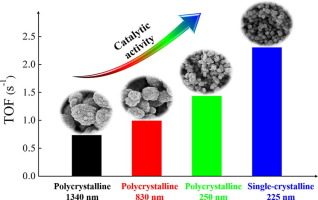Journal of Catalysis ( IF 7.3 ) Pub Date : 2018-02-22 , DOI: 10.1016/j.jcat.2018.01.033 Guanghua Ye , Yuanyuan Sun , Zhongyuan Guo , Kake Zhu , Honglai Liu , Xinggui Zhou , Marc-Olivier Coppens

|
The impact of particle size and internal grain boundaries of Beta zeolites was investigated in n-pentane isomerization over bifunctional Pt/Beta catalysts, by comparing the catalytic performance of four as-synthesized Pt/Beta samples that possess an identical Pt loading (0.5 wt%), but use four distinct Beta zeolites. Three of them contain polycrystalline zeolites, consisting of nano-sized crystals with a similar size of 9–13 nm, but having different average particle sizes (i.e., 1340, 830, and 250 nm) and numerous internal grain boundaries, as found via high-resolution transmission electron microscopy. The last catalyst contains single-crystalline zeolite, with an average particle size of 225 nm, and no observed internal grain boundaries. At low reaction temperature (<578 K), the particle size and internal grain boundaries do not change the apparent activity, because activity is controlled by reaction on the acid sites of the zeolite. At high reaction temperature (>614 K), a large particle size and the presence of internal grain boundaries significantly reduce the apparent activity, because of the extended diffusion path and additional diffusion barriers, which are probably caused by a mismatch in micropore alignment and gas-zeolite interfaces at these grain boundaries. Due to the small particle size and absence of internal grain boundaries, the observed activity for single-crystalline Beta can be 60–212% higher than for polycrystalline counterparts, even though it possesses a much weaker intrinsic acidity. This shows, remarkably, that single-crystalline zeolites with less internal grain boundaries can achieve a much higher catalytic activity.
中文翻译:

沸石粒径和内部晶界对Pt / Beta催化正戊烷异构化的影响
在n中研究了β沸石的粒径和内部晶界的影响通过比较四个具有相同Pt载量(0.5 wt%)但使用四种不同的Beta沸石的合成的Pt / Beta样品的催化性能,在双功能Pt / Beta催化剂上进行了戊烷异构化。它们中的三个含有多晶沸石,由纳米尺寸的晶体组成,具有相似的9-13 nm尺寸,但具有不同的平均粒径(即1340、830和250 nm),并且内部有许多晶界,这是通过高倍发现的。分辨率透射电镜。最后一种催化剂包含单晶沸石,平均粒径为225 nm,没有观察到内部晶界。在较低的反应温度(<578 K)下,粒径和内部晶界不会改变表观活性,因为活性受沸石酸性位点反应的控制。在较高的反应温度(> 614 K)下,大的粒径和内部晶界的存在会显着降低表观活性,这是因为扩展的扩散路径和附加的扩散壁垒可能是由于微孔排列和气体的不匹配所致-沸石在这些晶界处界面。由于粒径小且没有内部晶界,因此观察到的单晶Beta活性比多晶对应物高60-212%,尽管它的固有酸度要弱得多。值得注意的是,这表明具有较少内部晶界的单晶沸石可以实现更高的催化活性。大的粒径和内部晶界的存在会显着降低表观活性,这是由于扩展的扩散路径和附加的扩散壁垒,这可能是由于这些晶界处的微孔排列和气-沸石界面不匹配所致。由于粒径小且没有内部晶界,因此观察到的单晶Beta活性比多晶对应物高60-212%,尽管它的固有酸度要弱得多。值得注意的是,这表明具有较少内部晶界的单晶沸石可以实现更高的催化活性。大的粒径和内部晶界的存在会显着降低表观活性,这是由于扩展的扩散路径和附加的扩散壁垒所致,这可能是由于这些晶界处的微孔排列和气-沸石界面不匹配造成的。由于粒径小且没有内部晶界,因此观察到的单晶Beta活性比多晶对应物高60-212%,尽管它的固有酸度要弱得多。值得注意的是,这表明具有较少内部晶界的单晶沸石可以实现更高的催化活性。这可能是由于在这些晶界处的微孔排列和气-沸石界面不匹配造成的。由于粒径小且没有内部晶界,因此观察到的单晶Beta活性比多晶对应物高60-212%,尽管它的固有酸度要弱得多。值得注意的是,这表明具有较少内部晶界的单晶沸石可以实现更高的催化活性。这可能是由于在这些晶界处的微孔排列和气-沸石界面不匹配造成的。由于粒径小且没有内部晶界,即使单晶Beta的固有酸度要弱得多,其观察到的活性也可以比多晶Beta的活性高60–212%。值得注意的是,这表明具有较少内部晶界的单晶沸石可以实现更高的催化活性。


























 京公网安备 11010802027423号
京公网安备 11010802027423号